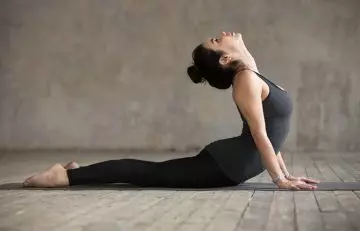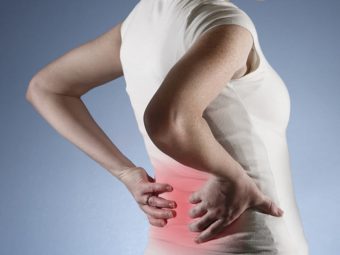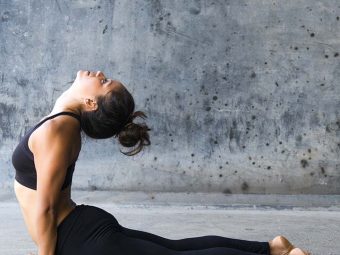12 Exercises For Upper Back Pain, Causes, & Prevention Tips

Image: Shutterstock
Did you bend to pick something up and felt a sharp pain in your upper back? Does doing even simple things, like lifting a cup, worsen the pain? While upper back pain is not as common as lower back pain, it is not any less painful. The good news is that there are a series of stretches that may help alleviate upper back pain. Keep reading to find out more about these stretches.
In This Article
Best Stretches To Get Rid Of Upper Back Pain
1. Pectoralis Stretch (Standing Wall Stretch)
This may help in relaxing tense shoulder and back muscles.
What You Have To Do
- Stand at an arm’s length from a wall.
- Press your palms against the wall at shoulder level.
- Lean towards the wall with your upper body, but without moving your palms.
- Hold this position for 5-10 seconds.
Repetitions
10-12
Sets
3
2. Thoracic Extension
Thoracic extension exercises help stretch the muscles of the back (1). Hence, they may help in reducing upper back pain.
What You Have To Do
- Kneel in front of a bench.
- Place your elbows on the bench such that they are shoulder-width apart.
- Kneel far enough from the bench so that you have ample space to drop your chest through the arms and extend your spine.
- With your knees firmly planted on the ground, press your chest towards the ground with your elbows bearing the weight.
- Extend your spine as much as possible.
- Hold the position for 5-10 seconds.
- Go back to the initial position.
Repetitions
10-12
Sets
3
3. Arm Slide On Wall (Shoulder Rotation)
This stretch works great for the biceps, shoulders, and upper back. It may help alleviate the pain caused by muscle strains.
What You Have To Do
- Stand against a wall with your glutes, shoulders, and head touching it.
- Put your hands out to your sides, touching the wall at 90 degrees.
- Draw in your abdominal muscles towards your spine.
- Lift your arms overhead while your shoulder blades and arms are planted to the wall.
- Don’t shrug or stoop or allow your lower back to arch.
- Hold this position for about 5 seconds and then return to the initial position.
Why This Works
This stretch works great for your biceps, shoulders, and upper back. It can help alleviate the pain caused by muscle strains.
Repetitions
12-15
Sets
3
4. Scapular Squeeze
Scapular squeeze aims at stretching the scapulae that include muscles as well as bones. This stretch increases the strength and flexibility of the scapulae.
What You Have To Do
- Stand tall with your back straight.
- Pull your shoulder blades towards your back but slightly lower such that your elbows are pulled back and inward.
- Hold the position for about 5 seconds.
- Return to the initial position.
- If you go to a gym, you may try out the seated cable rows and barbell rows as they serve the same purpose.
Repetitions
10-12
Sets
3
5. Mid-Trap Exercise – Prone Shoulder Horizontal Abduction
It is believed that mid-trap exercises often concentrate on the middle trapezius muscles. They may help in increasing the flexibility and strength of these muscles. However, there is no scientific research to back this claim.
What You Have To Do
- Lie flat on your front on an elevated surface, such as a single bed.
- Allow your arms to rest on either side in a ‘T’.
- Squeeze your shoulder blades as you lift one of your arms to its maximum.
- Lower your arms and repeat.
Repetitions
10-12
Sets
3
6. Thoracic Stretch – Rolling Spine
Thoracic stretches, like the rolling spine, may help in stretching the thoracic area. This may help in relieving tight and painful muscles.
What You Have To Do
- Lie down on a mat with your knees at right angles to the floor, and your palms flat on the mat.
- Raise your head and slowly pull your knees toward your abdomen.
- Rock back and forth slowly, such that you are rolling your spine, one vertebra at a time.
- Go back to the initial position and repeat.
7. Quadruped Arm And Leg Raise
The quadruped arm and leg raise helps strengthen the core and gives proper alignment to the spine (2).
What You Have To Do
- Sit on your hands and knees on a yoga or exercise mat. Your arms should be just below your shoulders, and your knees right below your hips.
- Extend one leg and the arm opposite to it such that it is aligned with your body.
- Return to the initial position and complete the repetitions.
- Repeat for the other leg and arm.
Repetitions
10-12
Sets
3
8. Rowing Exercise
Rowing is great for your arms, legs, core, and back. It may help in strengthening the muscles and promote flexibility.
What You Have To Do
- Sit erect with your legs and arms straight out.
- Pull your elbows back downwards.
- Move your body back and forth so that you are leaning slightly back when you pull your arms towards the chest.
- You can also fully bend your knees to the “catch” position as you complete a full stroke.
- Move back to the initial position and repeat.
- You can also carry out this workout at a gym.
Repetitions
10
Sets
3
9. Cobra Pose
Cobra pose is believed to be effective in reducing pain. This may help in strengthening the entire back and shoulders.
What You Have To Do
- Lie flat on your stomach on a yoga mat.
- Plant your toes on the floor, with your forehead resting on the ground.
- Keep your feet together, with your heels slightly touching each other.
- Place your hands under your shoulders, and keep your elbows close to your torso.
- Take a deep breath and slowly lift your chest, head, and abdomen while your navel is still touching the ground.
- Pull your torso back with your weight on your hands.
- Arch your back as far as possible and then tilt your head and look up.
Repetitions
10-12
Duration
15-30 seconds
10. Downward Dog Pose
It may help in strengthening your bones and muscles and alleviates back pain.
What You Have To Do
- Get on your fours on the floor. Your knees should be right below your hips, and your arms a little in front of your shoulders.
- Spread your palms and toes on the ground.
- Take a deep breath and exhale as you lift your knees away from the floor.
- Initially, keep your knees half bent and lift the heels away from the floor.
- Lengthen your tailbone away from your pelvis and towards your pubis.
- Push your thighs back and forth along with your heels.
- Straighten your knees slightly, but don’t lock them.
- Firm the thighs, arms, and the shoulder blades.
Duration
1-3 minutes
11. Posture Correction
This stretch may help in correcting your posture, which is one of the many triggers of upper back pain (3).
What You Have To Do
- Kneel on your right knee and place your left foot on the floor.
- Place both your hands on the left thigh and bend your hip forward until you feel a stretch in your hip flexors.
- Contract your abdominal muscles and tilt your pelvis back slightly.
- Keep your chin parallel to the ground.
- Hold this pose for 20-30 seconds and repeat with the other leg.
Repetitions
10
Sets
3
12. Thread The Needle
This pose may help relieve stiffness and pain in the upper back.
What You Have To Do
- Place your elbows right under your shoulders, and your knees under your hips. Keep your head in a neutral position in the center.
- As you exhale, slide your right arm underneath the left arm as your palm faces upwards.
Your right shoulder should touch the mat. - As you rest your right ear and cheek against the mat, gaze towards your left.
Your left elbow should be lifted, and your hips raised. Don’t press your entire weight on your head. - Adjust your position such that you don’t strain your neck or shoulder.
- Allow your upper back to broaden and your lower back to relax.
- Hold this position for a minute and then release the pose.
- Repeat on the other side.
Duration
1-2 minutes
In addition to these stretches, here are a few tips that may help in dealing with upper back pain and prevent its recurrence.
Prevention Tips
- Practice good posture, be it at work or at home.
- Exercise regularly.
- Maintain a healthy weight.
- Manage your stress levels.
Listed below are the causes of upper back pain.
What Causes Upper Back Pain?
A variety of factors may trigger back pain, like:
- Strain or injury to the back muscles due to overuse
- Poor posture
- A pinched nerve in the spine or close to the ribs
- Fractured backbone
- Damaged or displaced spinal disc (Herniated disc)
- Osteoarthritis, which causes the cartilage protecting the bones to wear down
- A chronic pain disorder called myofascial pain syndrome caused by the repetitive contraction of the muscles.
- Issues with the gallbladder, such as gallstones
- Pain between the shoulder blades
The sensation of pain in the upper back may vary from one person to another. Here are some common symptoms associated with upper back pain.
Signs And Symptoms
The pain that occurs is often described in the following terms:
- Stiffness
- Aching
- Sharp
- Burning
- Crampy
Upper back pain may result from mild to severe factors. It may be the result of something as minute as the overuse of the back muscles to something as serious as cancer (3).
Let us now look at the factors that put an individual at a higher risk of developing upper back pain.
Risk Factors
The risk factors for upper back pain include:
- Advancing age
- Weak muscles
- Obesity
- Underlying medical conditions, like sciatica, arthritis, osteoporosis, fibromyalgia, or even cancer.
- Smoking
A sedentary lifestyle, constant working at the desk, a sudden sprain, or injury can all result in upper back pain. While there are OTC creams and and painkillers available to deal with acute pain immediately, it’s best to handle chronic or repeated pain with the above tips, stretches, and exercises. Standing wall stretch, shoulder rotations, scapular squeeze, and rolling spine exercises are a few effective ways to deal with upper back pain. Include any of these in your daily workout routine to feel the improvement.
Frequently Asked Questions
How should I sleep with upper back pain?
Certain sleeping positions may help improve back pain. Try sleeping with a pillow between or underneath your legs for support. Those who sleep on their side may keep the pillow between the knees and draw it towards your chest. You may also use therapeutic pillows that can keep your neck in the correct position.
Do massages help upper back pain?
Yes, certain therapeutic massages may alleviate symptoms of back pain and also improve your range of motion.
References
Articles on StyleCraze are backed by verified information from peer-reviewed and academic research papers, reputed organizations, research institutions, and medical associations to ensure accuracy and relevance. Read our editorial policy to learn more.
- Yoo, Won-gyu. “Effect of thoracic stretching, thoracic extension exercise and exercises for cervical and scapular posture on thoracic kyphosis angle and upper thoracic pain.” Journal of physical therapy science 25.11 (2013): 1509-1510.
https://pubmed.ncbi.nlm.nih.gov/24396221/ - Hajihosseini, Elham, et al. “The effects of strengthening, stretching and comprehensive exercises on forward shoulder posture correction.” Physical Treatments-Specific Physical Therapy Journal 4.3 (2014): 123-132.
https://www.researchgate.net/publication/281200197_The_Effects_of_Strengthening_Stretching_and_Comprehensive_Exercises_on_Forward_Shoulder_Posture_Correction - Deyo, Richard A., and Andrew K. Diehl. “Cancer as a cause of back pain.” Journal of general internal medicine 3.3 (1988): 230-238.
https://link.springer.com/article/10.1007/BF02596337























